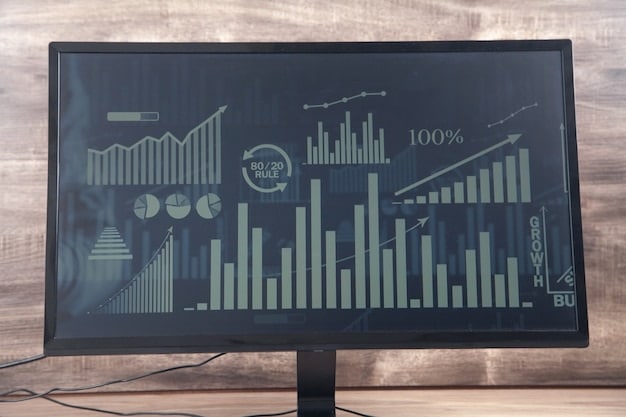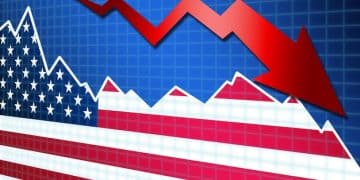Economic Indicators Mixed Signals: Navigating 2025 Uncertainty

Economic indicators in 2025 present a mixed picture, reflecting both resilience and emerging vulnerabilities across different sectors, requiring careful analysis to navigate the uncertain economic landscape.
The year 2025 presents a complex economic outlook, with economic indicators showing mixed signals: Navigating uncertainty in 2025 will require a deep understanding of underlying trends. Are we heading towards growth, a slowdown, or something in between? Let’s delve into the details and explore what these mixed signals mean for businesses and individuals alike.
Decoding Economic Indicators in 2025
Understanding economic indicators is essential for making informed decisions in an uncertain environment. These indicators provide valuable insights into the overall health and direction of the economy, helping businesses and individuals anticipate potential challenges and opportunities.
What are the key indicators to watch in 2025, and what are they telling us?
Gross Domestic Product (GDP)
GDP is a broad measure of economic activity. It represents the total value of goods and services produced within a country’s borders during a specific period. Changes in GDP indicate whether the economy is expanding or contracting.
Inflation Rate
The inflation rate measures the pace at which the general level of prices for goods and services is rising, and subsequently, purchasing power is falling. Monitoring inflation is crucial for assessing the stability of the economy and making adjustments to monetary policy.
- GDP Growth: Monitor trends to gauge overall economic health.
- Inflation Control: Keeping inflation at bay ensures price stability.
- Unemployment Rate: A healthy rate signifies a robust labor market.
- Consumer Confidence: Indicates spending and investment patterns.
In conclusion, understanding these core economic indicators is the bedrock for navigating economic uncertainty in 2025. By closely monitoring GDP, inflation, unemployment, and consumer confidence, businesses and policymakers alike can make well-informed decisions and strategically plan for the future.

The Labor Market’s Conflicting Signals
The labor market often provides a crucial snapshot of economic vitality. However, in 2025, the signals from the job sector are not entirely consistent, creating a degree of uncertainty.
What conflicting signs are we seeing, and what could they mean for employment and wages?
Unemployment Rate
The unemployment rate reveals the percentage of the labor force that is actively seeking employment but unable to find it. A low unemployment rate generally indicates a strong economy, while a high rate may signal an economic downturn.
Wage Growth
Wage growth reflects the rate at which workers’ earnings are increasing. Positive wage growth can signify a healthy labor market, while stagnant or declining wages may indicate economic weakness.
- Job Openings: High openings suggest employer demand.
- Labor Force Participation: The number of people actively employed or seeking work.
- Underemployment: Workers employed part-time who seek full-time work.
In summary, the labor market’s conflicting signals underscore the need for a nuanced approach to understanding economic dynamics in 2025. By closely monitoring unemployment rates, wage growth, job openings, and labor force participation, stakeholders can prepare for various potential outcomes in the job sector.
Consumer Spending: A Key Driver Under Pressure
Consumer spending is a major contributor to economic growth in many countries. Keeping an eye on consumer behavior is crucial to understanding economic health.
How is consumer spending holding up in the face of inflation and economic uncertainty?

Retail Sales
Retail sales measure the total value of goods and services sold to consumers through retail channels. Changes in retail sales reflect shifts in consumer demand and spending patterns.
Consumer Confidence
Consumer confidence indexes gauge how optimistic or pessimistic consumers are about the economy’s future. High consumer confidence typically leads to increased spending, while low confidence may result in reduced spending.
Instead of Subtitles, using a Continous structure:
Factors such as rising inflation and interest rates impact overall consumer spending by eroding purchasing power. As costs go up, consumers may cut back on discretionary purchases, affecting retailers and the broader economy.
Despite economic uncertainty, certain sectors might still see growth – for instance, essential goods and services are less sensitive to economic downturns. Monitoring these trends is crucial for businesses making strategic decisions.
Consumer behavior will continue to be a critical indicator of economic health. By closely tracking retail sales, consumer confidence, and spending patterns, businesses and policymakers can adjust strategies appropriately.
Global Economic Headwinds Affecting the US
The global economy can have a significant impact on the US economy. Monitoring international developments is essential for understanding potential risks and opportunities.
What global factors are most likely to influence the US economy in 2025?
Geopolitical Tensions
Geopolitical tensions, such as trade wars, political instability, and military conflicts, can disrupt international trade, increase uncertainty, and negatively impact economic growth.
Supply Chain Disruptions
Supply chain disruptions, caused by events like natural disasters or geopolitical events, can lead to shortages of goods, higher prices, and reduced economic activity.
- International Trade: Trade policies and global trade volumes.
- Currency Exchange Rates: Fluctuations influencing import and export costs.
- Commodity Prices: Changes impacting production costs in various industries.
In sum, these global factors underscore the interconnected nature of the modern economy. By monitoring geopolitical tensions, supply chain disruptions, and international trade dynamics, businesses and policymakers can anticipate and mitigate potential negative impacts on the US economy.
Interest Rates and Monetary Policy Decisions
Interest rates and monetary policy decisions play a crucial role in shaping economic conditions. Understanding these factors is essential for businesses and individuals alike.
How are central banks likely to respond to mixed economic signals in 2025?
Federal Reserve (The Fed) Actions
The Federal Reserve (The Fed) sets monetary policy in the US, influencing interest rates and the money supply. Its decisions can significantly impact economic growth, inflation, and employment.
Impact on Borrowing Costs
Changes in interest rates affect borrowing costs for businesses and consumers. Higher interest rates can discourage borrowing and investment, while lower rates can stimulate economic activity.
- Inflation Targets: Central banks aim to maintain price stability.
- Employment Goals: A focus on full employment influences monetary policy.
- Economic Stability: Balancing growth and managing inflationary pressures.
Interest rates and monetary policy decisions are pivotal in steering the economy. By closely monitoring central bank actions, businesses, investors, and average individuals can better prepare for potential shifts in borrowing costs, investment opportunities, and economic stability.
Sector-Specific Outlook: Winners and Losers
Different sectors of the economy may fare differently in an uncertain environment. Identifying potential winners and losers is crucial for making informed investment and business decisions.
Which sectors are positioned to thrive, and which might struggle in 2025?
Technology Sector
The technology sector may continue to grow due to increasing demand for digital services, artificial intelligence, and cloud computing. Companies in these areas could see strong performance.
Energy Sector
The energy sector’s outlook depends on factors such as oil prices, renewable energy investments, and government policies. Companies focused on sustainable energy solutions may experience growth, while traditional energy companies could face challenges.
- Healthcare: Demand remains steady due to aging populations.
- Consumer Staples: Essential goods offer stability in downturns.
- Discretionary Spending: These sectors often suffer during economic slowdowns.
Different sectors respond uniquely to economic uncertainty. Staying informed on sector-specific developments enables strategic positioning and decision-making. Whether monitoring the growth potential in technology and healthcare or identifying stability in consumer staples, having this information ensures businesses and investors can successfully navigate the economic landscape in 2025.
| Key Aspect | Brief Description |
|---|---|
| 📊 Economic Indicators | Mixed signals from GDP, inflation, and unemployment require careful assessment. |
| 💼 Labor Market | Conflicting data on job growth, wages, and labor participation creates uncertainty. |
| 🛒 Consumer Spending | Inflation and confidence levels significantly affect retail sales and consumer behavior. |
| 🌍 Global Factors | Geopolitical tensions and supply chain issues influence the US economic outlook. |
Frequently Asked Questions
▼
Key indicators include GDP growth, inflation rate, unemployment rate, and consumer confidence. These metrics provide insights into economic health and potential shifts. Monitoring these is crucial for making informed decisions.
▼
Global events such as trade wars, geopolitical tensions, and supply chain disruptions can significantly affect the US economy by creating price instability and trade imbalances. Being aware helps mitigate risks.
▼
The Federal Reserve sets monetary policy, influencing interest rates and money supply. Its actions impact borrowing costs and economic growth. Understanding these policies helps anticipate market movements.
▼
Sectors like technology, healthcare, and consumer staples often fare well. Technology continues to grow, healthcare remains steady, and essential goods provide stability. Each offers unique investment prospects.
▼
Consumers can adjust by budgeting wisely, prioritizing essential spending, and closely monitoring expenses. Building an emergency fund provides financial security and helps mitigate unexpected economic changes effectively.
Conclusion
In conclusion, navigating the uncertain economic landscape of 2025 requires careful attention to mixed signals from various economic indicators. By staying informed, understanding the interplay of domestic and global factors, and making strategic decisions, businesses and individuals can better prepare for and adapt to the challenges and opportunities that lie ahead.





